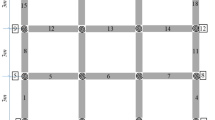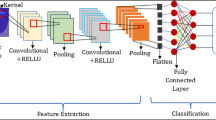Abstract
Due to the complex structure of most frame structure, a large amount of sensor data needs to be processed for damage diagnosis, which increases the computational cost of diagnosis models and poses a serious challenge to their fast, accurate, and efficient damage diagnosis. In order to address this issue, this paper proposes a novel lightweight damage diagnosis method of frame structure for mobile devices based on convolutional neural networks. This method first uses mean filtering to process the vibration data collected by sensors, and then innovatively combines two convolutional neural network models, ShuffleNet and GhostNet, to form a new lightweight convolutional neural network model called SGNet, thereby reducing the computational cost of the model while ensuring diagnosis accuracy. In order to test the performance of the method proposed in this article, experimental research on damage degree diagnosis and damage type diagnosis is conducted by taking the frame structure provided by Columbia University as the research object, and comparative experiments of performance are conducted with MobileNet, GhostNet, and ShuffleNet. The experimental results show that the lightweight damage diagnosis method for frame structure proposed in this article not only has high damage diagnosis accuracy, but also has fewer computational parameters, when the highest accuracy is 99.8%, the computational parameters are only 1 million. At the same time, it is superior to MobileNet, GhostNet, ShuffleNet in terms of diagnosis accuracy and computational cost, so it is an effective high-precision lightweight damage diagnosis method for frame structure.



















Similar content being viewed by others
References
Zeng Z (2020) Analysis and exploration of the application and development of neural network technology in mechanical engineering. Science and Technology Innovation and Application 18:153–154 (in Chinese)
Gul M, Catabas FN (2011) Structural health monitoring and damage assessment using a novel time series analysis methodology with sensor clustering. Sound of Sound and Vibration 33:1196–1210
Yin X (2013) Discussion on the existing problems and solutions in contemporary civil construction. Science and Technology Innovation and Application 32:241–248 (in Chinese)
Li H, Zhang Q, Qin X, Sun Y (2018) Bearing fault diagnosis method based on short−time Fourier transform and convolutional neural network. Vibration and Shock 37(19):124–131 (in Chinese)
Jiang J, Wang H, Ke Y (2017) Fault diagnosis based on LTSA and K−nearest neighbor classifier. Vibration and Shock 36(11):134–139 (in Chinese)
Cai E, Li C, Liu D (2015) Rolling bearing fault diagnosis method based on local mean decomposition and K−nearest neighbor algorithm. Modern Electronics Technique 38(13):50–52 (in Chinese)
Feng E, Pan H (2010) Research on diesel engine fault diagnosis based on fuzzy clustering analysis. Machinery Management and Development 1:25–26 (in Chinese)
Luo M, Zhang T, Meng X (2010) Fault diagnosis technology for aerospace launch based on fuzzy clustering analysis. Computer Engineering and Design 8:155–157 (in Chinese)
Su L, Guo J (2020) Research on lubricating oil particle detection based on improved ensemble empirical mode decomposition method. Journal of YanShan University 44(5):477–486 (in Chinese)
Li X, Law S (2010) Matrix of the covariance of covariance of acceleration responses for damage detection from ambient vibration measurements. Mech Syst Signal Process 24(4):945–956
Malekjafarian A, Brincker R, Ashory M (2012) Modified Ibrahim time domain method for identification of closely spaced modes: Experimental results. In: Proceedings of the 30th IMAC, A Conference on Structural Dynamics, Topics on the Dynamics of Civil Structures, Volume 1, 2012. Springer New York, pp 443–449
Yang J, Lei Y, Lin S (2004) Hilbert−Huang based approach for structural damage detection. J Eng Mech 130(1):85–95
Li H, Deng X, Dai H (2007) Structural damage detection using the combination method of EMD and wavelet analysis. Mech Syst Signal Process 21(1):298–306
Zhu X. Bearing fault diagnosis method based on wavelet packet decomposition and K−nearest neighbor algorithm. Equip Manuf Technol 2020(2), 24–27+45. (in Chinese)
Tong G (2020) Motor fault recognition method based on machine vision and experimental research. Experimental Technology and Management 37(4):71–77 (in Chinese)
Zhu H, Li Q, Ma T (2022) Application and fault analysis of machine vision in online wire harness assembly. Information and Computer 34(12):100–102 (in Chinese)
Krizhevsky A, Sutskever I, Hinton G (2012) Imagenet classification with deep convolutional neural networks. Adv Neural Inf Proces Syst:1097–1105
Devlin J, Chang M, Lee K (2018) BERT: Pre−training of deep bidirectional transformers for language understanding. arXiv preprint arXiv:1810.04805
Chen Y, Wang C (2012) Research on fault diagnosis method based on natural language understanding. Computer Measurement & Control 20(03):610–613 (in Chinese)
Li J (2022) Recent advances in end-to-end automatic speech recognition. APSIPA Transactions on Signal and Information Processing 11(1):1–64
Lee W, Seong J, Lu B (2021) Biosignal sensors and deep learning−based speech recognition: a review. Sensors 21(4):1399
Huang K, Shi B, Li X (2022) Multi−modal sensor fusion for auto driving perception: a survey. arXiv preprint arXiv:2202.02703
Bojarski M, Testa D, Dworakowski D (2016) End to end learning for self−driving cars. arXiv preprint arXiv:1604.07316
Kostić B, Gül M (2017) Vibration−based damage detection of bridges under varying temperature effects using time−series analysis and artificial neural networks. J Bridg Eng 22(10):04017065
Khodabandehlou H, Pekcan G, Fadali M (2019) Vibration−based structural condition assessment using convolution neural networks. Struct Control Health Monit 26(2):e2308
Avci O, Abdeljaber O, Kiranyaz S (2019) Convolutional neural networks for real−time and wireless damage detection. In: Proceedings of the 37th IMAC, A Conference and Exposition on Structural Dynamics, 2019, Volume 2. Springer International Publishing, pp. 129–136
Tang Z, Chen Z, Bao Y (2019) Convolutional neural network−based data anomaly detection method using multiple information for structural health monitoring. Struct Control Health Monit 26(1):e2296
Cuşkun Y, Kaplan K, Alparslan B. Classification of the brain metastases based on a new 3D deep learning architecture. Soft Comput 2023: 1–14
Al-Areqi F, Konyar MZ (2022) Effectiveness evaluation of different feature extraction methods for classification of covid-19 from computed tomography images: a high accuracy classification study. Biomedical Signal Processing and Control 76:103662
Yue S, Lei W, Xue Y (2021) Research on fault diagnosis method based on deep adversarial transfer learning. Mechanical Science and Technology:1–7 (in Chinese)
Zhang X, Zhou X, Lin M (2018) Shufflenet: an extremely efficient convolutional neural network for mobile devices. Proceedings of the IEEE conference on computer vision and pattern recognition. 6848–6856
Han K, Wang Y, Tian Q, Guo J (2020) GhostNet: more features from cheap operations. Proceedings of the IEEE Computer Society Conference on Computer Vision and Pattern Recognition:1577–1586
Howard A, Zhu M, Chen B (2017) Mobilenets: Efficient convolutional neural networks for mobile vision applications. arXiv:1704.04861, 1–9
He K, Zhang X, Ren S (2016) Deep residual learning for image recognition. Proc IEEE Conf Comput Vis Pattern Recognit:770–778
Krizhevsky A, Sutskever I, Hinton G (2012) Imagenet classification with deep convolutional neural networks. Advances in neural information processing systems, In NeurIPS, pp. 1097–1105
Simonyan K, Zisserman A (2014) Very deep convolutional networks for large−scale image recognition. arXiv preprint arXiv:1409.1556
Abdeljaber A, Avci O, Kiranyaz S (2018) 1−DCNNs for structural damage detection: verification on a structural health monitoring benchmark data. Neurocomputing 275:1308–17
Ren J, Cai C, Chi Y (2022) Integrated damage location diagnosis of frame structure based on convolutional neural network with inception module. Sensors 23(1):418
Zhang W, Peng G, Li C (2017) A new deep learning model for fault diagnosis with good anti-noise and domain adaptation ability on raw vibration signals. Sensors 17(2):425
Zhang W, Li C, Peng G (2018) A deep convolutional neural network with new training methods for bearing fault diagnosis under noisy environment and different working load. Mech Syst Signal Process 100:349–543
Xue Y, Cai C, Chi Y (2022) Frame structure fault diagnosis based on a high-precision convolution neural network. Sensors 22:9427
Funding
This work was supported by Hebei Natural Science Foundation under Grant no E2023402071 and Key Laboratory of Intelligent Industrial Equipment Technology of Hebei Province (Hebei University of Engineering) under Grant no 202204 and 202206.
Author information
Authors and Affiliations
Corresponding author
Ethics declarations
Conflict of Interest
The authors declare no conflict of interests.
Additional information
Publisher’s Note
Springer Nature remains neutral with regard to jurisdictional claims in published maps and institutional affiliations.
Rights and permissions
Springer Nature or its licensor (e.g. a society or other partner) holds exclusive rights to this article under a publishing agreement with the author(s) or other rightsholder(s); author self-archiving of the accepted manuscript version of this article is solely governed by the terms of such publishing agreement and applicable law.
About this article
Cite this article
Cai, C., Fu, W., Guo, X. et al. A Lightweight Damage Diagnosis Method for Frame Structure Based on SGNet Model. Exp Tech (2024). https://doi.org/10.1007/s40799-023-00697-3
Received:
Accepted:
Published:
DOI: https://doi.org/10.1007/s40799-023-00697-3




